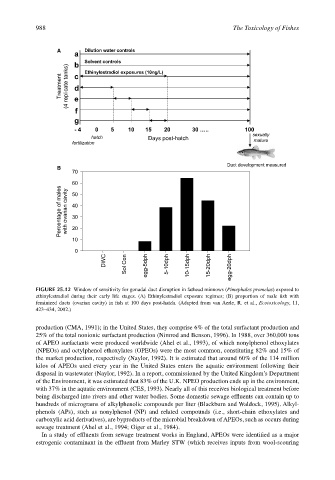Page 1008 - The Toxicology of Fishes
P. 1008
988 The Toxicology of Fishes
A.
B.
FIGURE 25.12 Window of sensitivity for gonadal duct disruption in fathead minnows (Pimephales promelas) exposed to
ethinylestradiol during their early life stages. (A) Ethinylestradiol exposure regimes; (B) proportion of male fish with
feminized ducts (ovarian cavity) in fish at 100 days post-hatch. (Adapted from van Aerle, R. et al., Ecotoxicology, 11,
423–434, 2002.)
production (CMA, 1991); in the United States, they comprise 6% of the total surfactant production and
25% of the total nonionic surfactant production (Nimrod and Benson, 1996). In 1988, over 360,000 tons
of APEO surfactants were produced worldwide (Ahel et al., 1993), of which nonylphenol ethoxylates
(NPEOs) and octylphenol ethoxylates (OPEOs) were the most common, constituting 82% and 15% of
the market production, respectively (Naylor, 1992). It is estimated that around 60% of the 114 million
kilos of APEOs used every year in the United States enters the aquatic environment following their
disposal in wastewater (Naylor, 1992). In a report, commissioned by the United Kingdom’s Department
of the Environment, it was estimated that 83% of the U.K. NPEO production ends up in the environment,
with 37% in the aquatic environment (CES, 1993). Nearly all of this receives biological treatment before
being discharged into rivers and other water bodies. Some domestic sewage effluents can contain up to
hundreds of micrograms of alkylphenolic compounds per liter (Blackburn and Waldock, 1995). Alkyl-
phenols (APs), such as nonylphenol (NP) and related compounds (i.e., short-chain ethoxylates and
carboxylic acid derivatives), are byproducts of the microbial breakdown of APEOs, such as occurs during
sewage treatment (Ahel et al., 1994; Giger et al., 1984).
In a study of effluents from sewage treatment works in England, APEOs were identified as a major
estrogenic contaminant in the effluent from Marley STW (which receives inputs from wool-scouring

